
Huron VR Show
Huron is a leader in digital transformation, helping organizations optimize operations with ERP, EPM, CRM, AI, and strategy solutions. This VR experience showcases Huron’s innovative approach by immersing users in a transformer-themed journey, demonstrating the power of digital maturity. Through interactive gameplay, it engages customers, qualifies leads, and reinforces Huron’s market positioning as a digital transformation leader.
Problem Statement
The client seeks to create a VR experience that showcases Huron's Digital Transformation through interactive mini-games, primarily for trade shows and events. As a designer, my role is to craft the visual narrative, translating the client and project team's story into an engaging design that sets the foundation for the VR team to develop. The focus is on building a compelling, immersive experience that educates and captivates users.
Challenges
-
Designing HUD & UI: Create an intuitive HUD that supports easy navigation within the 30-60 second gameplay.
-
User Stories & Flow: Map out user journeys, ensuring each scene and mini-game is clear and engaging in the short timeframe.
-
Wireframing Scenes: Design wireframes for each mini-game, ensuring smooth transitions and visual appeal within the time limit.
-
Maintaining Engagement: Keep users engaged and immersed within the brief 30-60 second experience.
-
Visual Storytelling: Translate the client’s ideas into a cohesive visual narrative that aligns with the Digital Transformation theme.
Timeline
July 2024 - Sep 2024
(Successful show)
Role
Lead UX/UI Designer
(Research, Visual Design, Graphic Design, Expeirence Design)
Team
Teamwork, with another Product Designer, worked closely with project manager and VR team
Choosing the environment
The client provided instructions and requirements outlining their vision. Based on that, my team and I explored various images to capture the desired user experience. Additionally, considering the requirements, we identified key environments to focus on such as busy city locations, interfaces of the games.

Requirements & game road map

Environment inspiration and research
Discovering the story
During the environment finalization phase, we began translating the requirements into a cohesive story. This involved creating user flows, establishing the foundation for each scene, determining their sequence, and mapping out how the game would progress.

Userflow
-
Game planning the flow
Subsequently, the discovery process focused on refining the user flow, uncovering key details, and strategically planning the overall experience narrative. The second journey map serves as the foundational plan to guide the VR development team in their planning and execution.
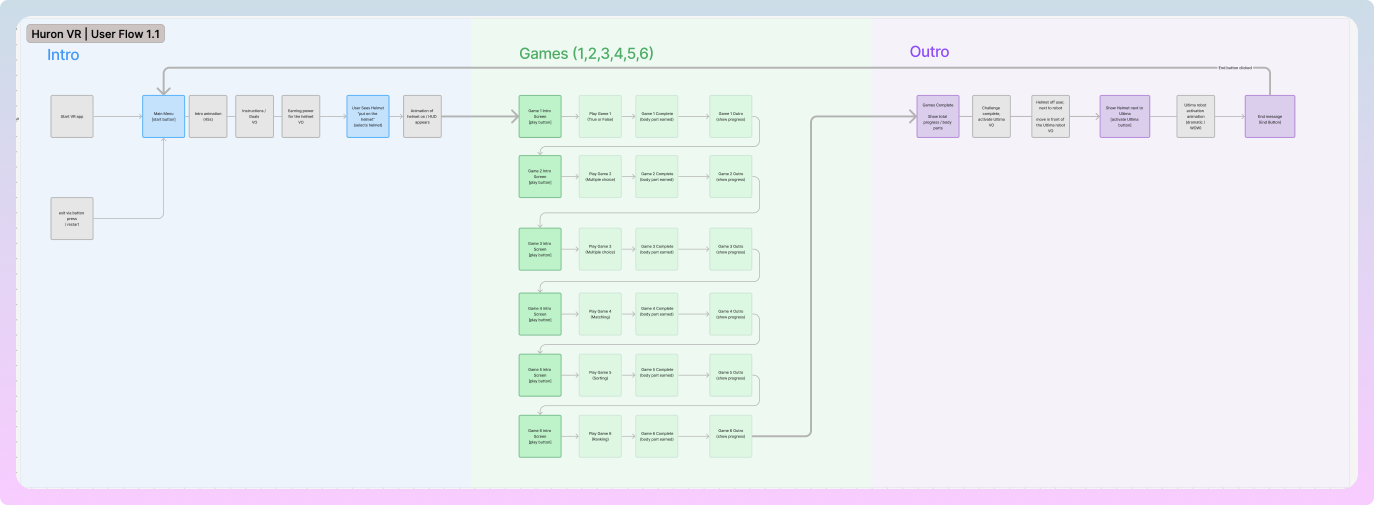
Userflow 2 - Game planning
The game flow was finalized to provide everyone with a clear visual representation of the entire experience while the user is wearing the VR headset. A comprehensive list of screens was also outlined to ensure a seamless journey.
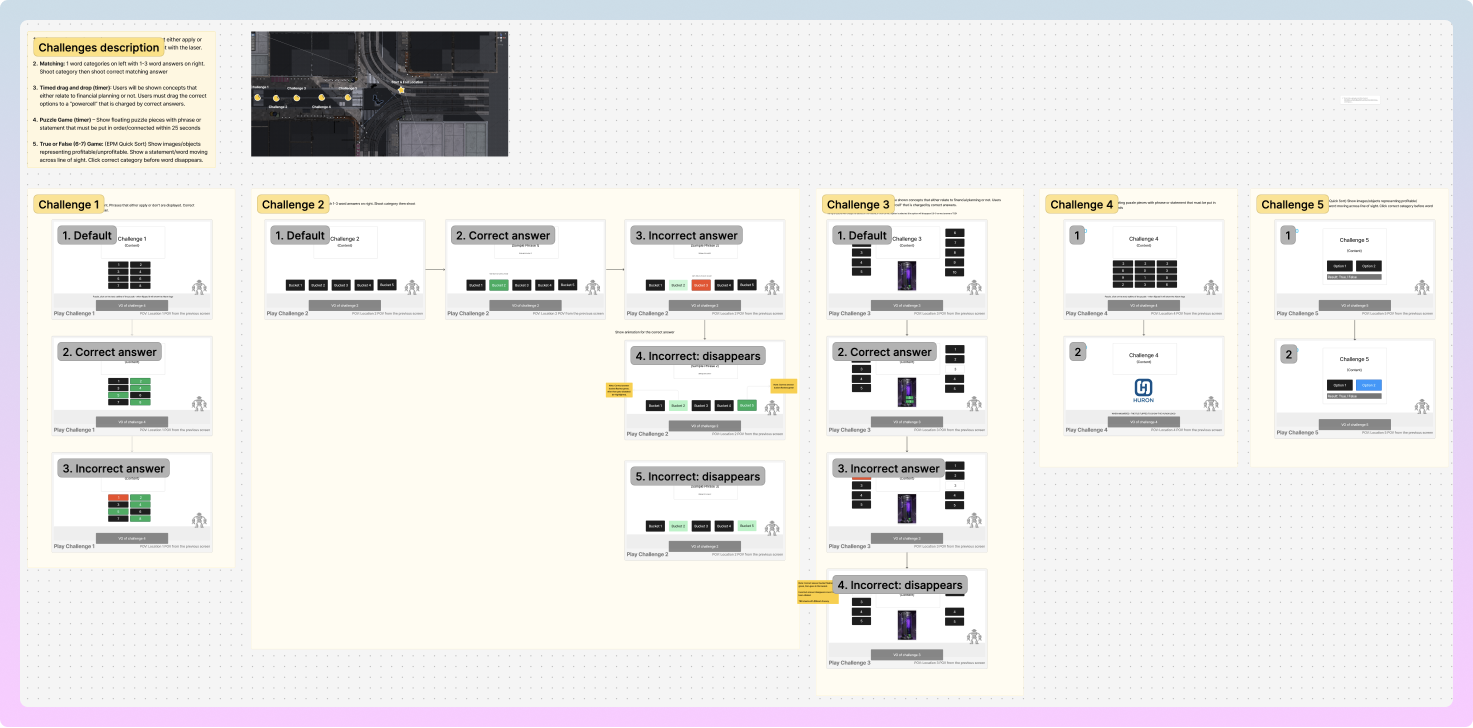
Finalising all the 5 games
To structure the experience, we focused the story into the three segments: Intro, Challenges, and Outro.
-
Intro: The journey begins as the user puts on the VR headset. The initial environment is dark, setting the stage for the experience.
-
Challenges: Once the intro screen plays, the user enters a series of five interactive challenges designed to gradually bring light and energy into the environment. These challenges are engaging, game-like interactions that contribute to the transformation of the space. The core idea revolves around a robotic presence that elevates and enhances the surroundings.
-
Outro: After completing all five challenges, the outro sequence unfolds, illuminating the entire environment as a culmination of the user's journey.
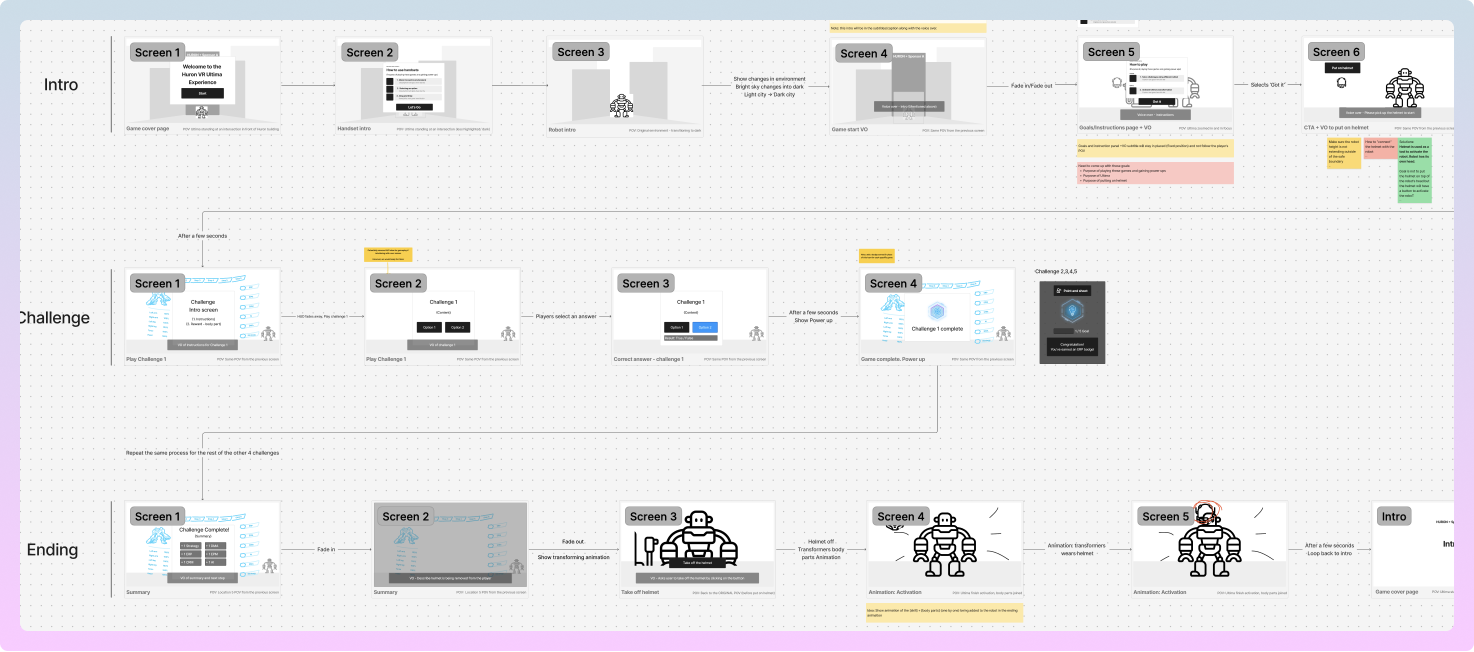
Storyboarding & HUD sketches
Wireframing storyboard
The next step is wireframing the UI while considering the environment's requirements and using the storyboard so far.
-
Lo-Fi wireframes
While creating the wireframes, the goal was to refine each story into a more polished form beyond initial sketches. This phase was crucial for tracking time spent on each segment, especially since the challenge was to keep each phase under 60 seconds. The story was visually structured at this stage to ensure a seamless flow.
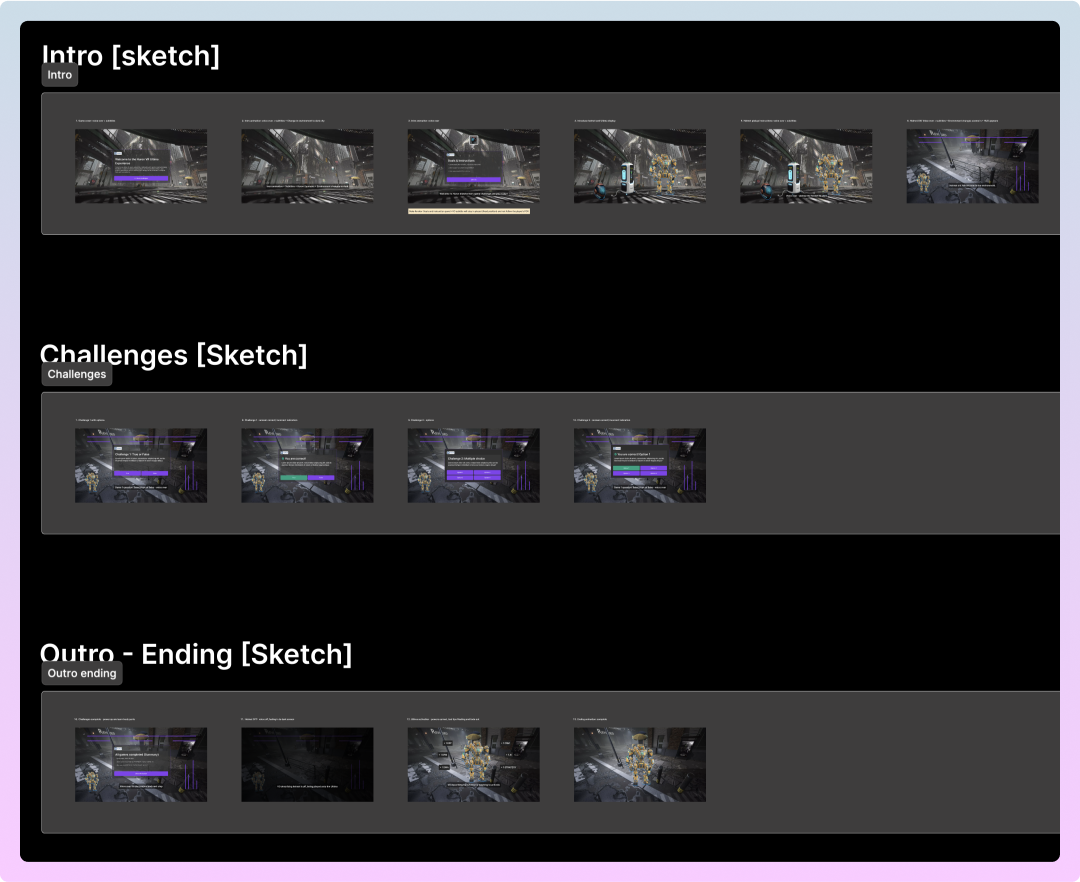
Lo-fi wireframing
Additionally, rough HUD sketches helped determine how to represent the robot’s progression beyond just visual design changes. This phase was essential for collaboration with the client, PM, 3D design, and development teams, ensuring alignment on storytelling and functionality.
Finalizing the UI cards for the challenges was crucial, as they served as the foundation for building the actual challenge cards in the final stages of the wireframe. This ensured that all the necessary elements and interactions were in place for the complete user experience.
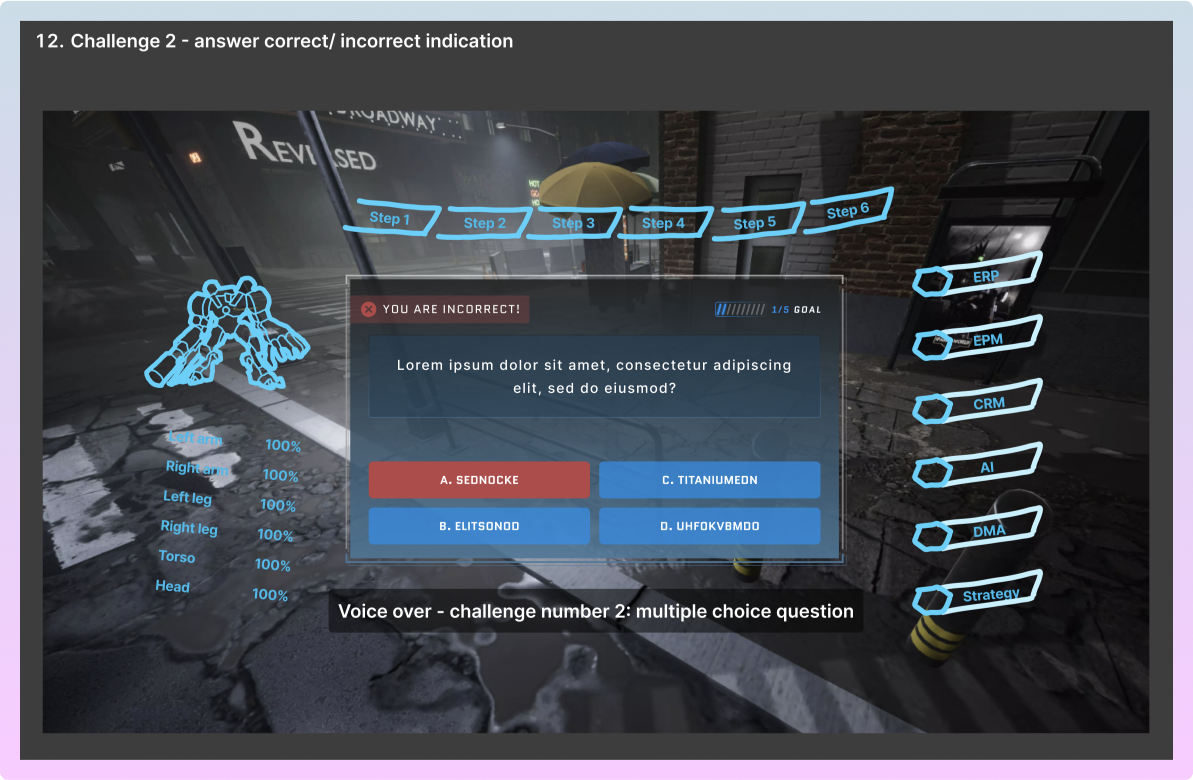
Designing UI cards & HUD elements
Designing HUD & Components
Designing the HUD was a crucial step after mapping out the visual story. Our goal was to integrate key gameplay elements seamlessly, including a timer for each game and indicators for the body parts that are progressively assembled to form the robot. As players complete challenges, they earn values that power up the robot, ultimately bringing it to life in the finale. Each of these challenge rewards represents an important business educational value, reinforcing the learning aspect of the experience.
While finalizing the HUD, we also needed to determine the UI for the challenges, aligning it with the storyboard for each challenge. This involved confirming which elements would be displayed when the user is wearing the VR headset, ensuring everything was clear and intuitive to enhance the immersive experience.
1. HUD Components
Using the rough HUD sketches from the wireframe phase, I moved on to illustration tools to refine the design, structuring the HUD into four key sections:
-
Timer – Displays the countdown for each game.
-
Progress Bar – Positioned at the top to track challenge completion.
-
Body Parts Indicator – Located on the left, filling up as challenges are completed to visually build the robot.
-
Challenge Values Display – Showcasing the key business educational values learned in each phase.

Designing UI elements on
2. Robot UI
Next, I focused on designing the UI for the robot, ensuring that every phase of its transformation was mapped to specific moments in the experience. This included detailing what happens at each scene transition—for example, the robot’s state before and after Challenge 1, and its progression through each subsequent challenge—ensuring a clear visual and interactive journey throughout the experience.
Each body part has the UI for different states, using the polished version the next step was to finalise the color schemes to the client of the whole HUD.

Designing UI elements on
3. Finalising the visual design
This phase also involved designing badges and icons, along with detailing the props for the final visual design. This ensured that all elements were visually cohesive and aligned with the overall user experience, adding clarity and enhancing the interaction flow.

Visual design for cards and HUD
Devlivery & Development
Once the HUDs were finalized, I created the spec sheet and component delivery sheet, detailing the interaction states and adding notes for clarity. This thorough documentation made the process much more efficient, saving time and improving communication between the design and development teams. The dev team had clear guidance, ensuring smooth handoffs to both the 3D team and the developers, thanks to the well-organized process we followed beforehand.

Spec sheet delivery
The VR Experience Video
Once the HUDs were finalized, I created the spec sheet and component delivery sheet, detailing the interaction states and adding notes for clarity. This thorough documentation made the process much more efficient, saving time and improving communication between the design and development teams. The dev team had clear guidance, ensuring smooth handoffs to both the 3D team and the developers. The client and PM team finalized the audio to complement the graphics, ensuring that the sound design aligned perfectly with the visual elements for a seamless and immersive experience.
